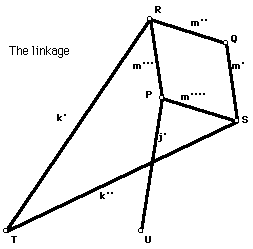Next:
Inversion
Up: Peaucellier's Linkage Table of Contents
Prev: Introduction

Peaucellier's Linkage
Part 1. Construct the Linkage
Construct the linkage as follows. Once you have a sketch, make this
procedure into a script.
- Start with three segments off to the side which determine your three
lengths; label them j, k, and m.
- Construct your two "fixed" points T and U so that the distance
between them is the same as the length of j.
- Now construct P so that the distance from P to U equals that from T
to U and so that P is free to move around U.
- How do you determine the placement of R and S? Remember that they
are both a specified distance (the length of k) from T and a specified
distance (m) from P. Construct them.
- To determine the placement of Q, use the fact that PRQS must be a rhombus.
You could construct Q using either intersections of parallel lines or intersections
of circles. For technical reasons, intersections of parallel lines works
better. Construct Q.
- After completing your sketch, move P while you trace P and Q to form
conjectures as to the shapes their traces lie on.
- Change the lengths of the three segment and move P while you trace
P and Q again. Does your conjecture remain true?
By now you have formulated a conjecture for the shape traced by Q as
P moves. The next question is: Why do P and Q behave as they do? In the
next section, you will learn about inversion. In part 3, you apply this
knowledge to your linkage to understand why P and Q move as they do.
Next: Inversion
Up: Peaucellier's Linkage Table of Contents
Prev: Introduction
![[HOME]](/pix/home.gif) The Geometry Center Home Page
The Geometry Center Home Page
Author: Evelyn Sander
Comments to: webmaster@geom.umn.edu
Created: Jun 09 1996 --- Last modified: Jun 11
1996
